A Short History of Archaeology at Colonial Williamsburg
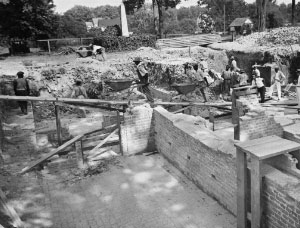
Evolving Goals and Techniques
Excavation, in one form or another, has been an important feature of Colonial Williamsburg's research since 1928. In that year, a group of laborers was set to work exposing the foundations of the Capitol building at the east end of Duke of Gloucester Street. This project, motivated by architectural interest, was the first of now hundreds that would help inform the careful reconstruction of this 18th-century town, and would eventually lead researchers to a more detailed and complete understanding of the lives of those who made their homes here.
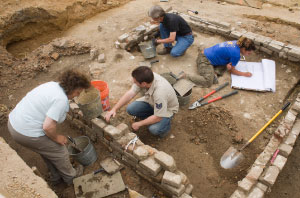
Colonial Williamsburg's Historic Area, by all outward appearances, is a "finished product." With more than 85 years of excavation behind us, it might seem safe to assume that all of the archaeological work has been completed. In fact, this is nowhere close to true. Only an estimated 15 to 20% of the Historic Area's 301 acres have been fully excavated. This statistic speaks not only to the labor-intensive nature of archaeological excavation but, more importantly, to archaeology's evolving goals and techniques as they have been practiced in Williamsburg for the last 85 years.
Looking back, the history of excavation at Colonial Williamsburg can be separated into four chapters. While these divisions are often aligned with changes in leadership, there are also distinct goals and methodologies identifying each (see detailed descriptions below). The first phase was defined by the reconstruction of Williamsburg as a town. During this period, more than 300 buildings were reconstructed based on architectural evidence, adding to the 88 structures that had survived from the 18th century. The hallmark of the second period was the introduction of open-area, stratigraphic excavation, and a focus on artifacts—techniques that spelled the difference between the "excavation" of the first phase, and the advent of "true archaeology" in Williamsburg. More recent phases can be characterized more as evolutions than as new disciplinary directions. During the third phase, new technology expanded the breadth of archaeological evidence, and a comparative approach opened new areas of research. The most recent changes, phase four, have much to do with the presentation of archaeological information, and engagement with communities.
Excavating an entire town is an enormous undertaking, and there will be opportunities for visitors to see active archaeological sites in Williamsburg for a long time to come. You might not, however, see an archaeological excavation each time you visit. That is because archaeologists, particularly in a protected town such as Williamsburg, are guided by a conservation ethic. Sites are excavated only when motivated by challenging research questions, and only when there is adequate funding not just for the excavation, but for lab work, artifact conservation, and report writing. Conservation also demands that some sites, or portions of sites, be "banked"—saved for a time when new questions or better technology might yield superior results.
In the meantime, the goal of archaeological excavation is to produce a representative sample of 18th-century Williamsburg: to excavate properties at the commercial (east) end, as well as some of the more gentrified "urban plantations" on the northwestern side of town; sites once occupied by the affluent, and tenant sites; sites where trades were practiced; as well as domestic and industrial sites. Overarching this mission is a commitment to filling in gaps, particularly toward understanding the lives of Williamsburg's large enslaved African and free black and Indian populations.
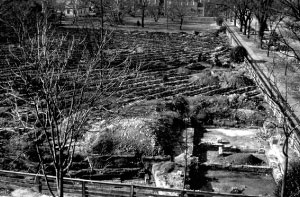
The Earliest Phase: 1928–1958
For the first thirty years of Colonial Williamsburg's history, the goals and methods of excavation were simple, straightforward, and so architecturally-oriented that today we self-consciously avoid calling the work "archaeology" at all. Excavation between 1928 and 1958 focused entirely on the problem of finding the physical remains of Williamsburg. Although 88 buildings survived from the 18th century, almost four times that number had fallen into disrepair and been razed over the course of the ensuing centuries.
The job of locating these structures fell to the large number of unemployed laborers that the Depression years had to offer. These men were set to work "cross-trenching": digging trenches one shovel blade wide (about one foot), and one shovel handle apart (about five feet), from one property boundary to the opposite side. When brick foundations were encountered, the workmen trenched around them, allowing an architect and a draftsman to draw what remained and to determine whether the structure dated to the 18th century.
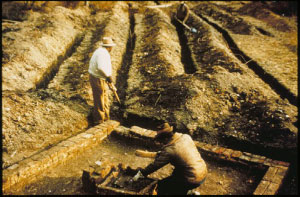
Cross-trenching proved to be a very successful means of locating building foundations. As a technique, it was quick and relatively inexpensive, making it the "discovery" method of choice not only in Williamsburg but also on other prominent sites, such as Jamestown Island. By the late 1950s an estimated 75% of the Historic Area had been cross-trenched, and the job of reconstructing the physical town was nearly complete. Yet something was missing.
While trenching turned out to be an excellent means of fast and accurate reconstruction, it produced little information about the people and the daily activity that made Williamsburg a vibrant 18th-century town. One of the primary problems with the technique was that artifacts—the evidence of those lives and activities—were not collected in any systematic way. Although excavators saved up to three 15-by-28-by-15-inch boxes of artifacts per property, most of these were architectural fragments—locks, hinges, bits of marble mantle—considered useful for the purposes of reconstruction. Workers also collected an assortment of unusual objects that caught their attention, but very few of the everyday items—ceramics, bottle glass, tobacco pipe fragments, and animal bones—that define 18th-century life for today's archaeologists. Fortunately, these practices—fairly common at the time—were about to come to an end at Colonial Williamsburg.
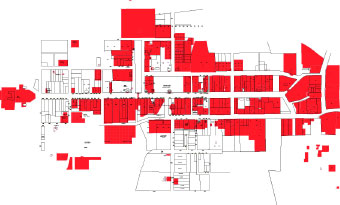
Defining characteristics of the Earliest Phase:
- Wholesale excavation ("unstructured" excavation of buildings like the Capitol and the Governor's Palace whose locations were well-known).
- Cross-trenching: Excavation at a 90 degree angle (1928–1938) or a 45 degree (1938–1958) to the street in order to recover building remains.
- Little regard for artifacts.
- Excavation as an architectural tool.
- Historical archaeology had not yet emerged as a discipline.
Examples of excavated sites:
All major public buildings, including the Governor's Palace, the Capitol, the Raleigh Tavern; domestic sites such as the Wythe, Peyton Randolph, and Brush-Everard sites; trade sites such as the James Geddy Foundry, and the Anderson Blacksmith Shop.
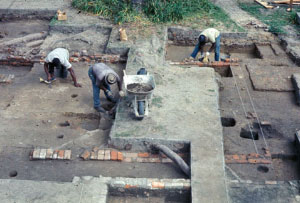
Establishing Archaeology: 1958–1982
In the late 1950s a British archaeologist named Ivor Noël Hume was hired as the foundation's first full-time trained archaeologist. Under his leadership, excavation was separated from the Office of Architecture and evolved into a discipline very similar to the archaeology practiced today.
Noël Hume instituted two crucial changes to the excavation program. The first was the introduction of open-area, stratigraphic excavation. Whereas early excavation had relied on narrow trenches to locate brick foundations, Noël Hume was interested in all of the many activities that had occurred on a site, and their relationship to one another. In order to reveal these, he opened up excavation areas that encompassed entire back yards. Sites were gridded into ten-foot squares with balks between the units to allow for the passage of wheelbarrows. The tools changed too. Shovels were traded for trowels, which were used to carefully remove soil layers.
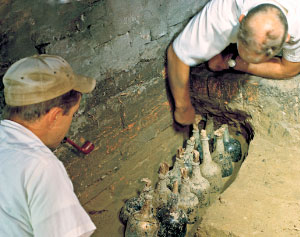
As excavators worked their way down through the site's history they began to uncover many of the features that had been missed by earlier trenching: trash pits, post holes identifying the locations of fence lines or lightly constructed buildings, gardens, and backyard work areas.
Noël Hume's second major innovation was the systematic retrieval of artifacts, not just those that were pretty or unusual, or might enhance an architectural reconstruction. Once those artifacts had been collected and their locations carefully noted, he used them to help assign dates to soil layers, and to reveal some of the activities of site inhabitants.
While Noël Hume excavated a significant number of sites during his tenure at Colonial Williamsburg, it was one of his earliest projects, the excavation of Wetherburn's Tavern, which showcased the advantages of careful, stratigraphic excavation. Asked to define a sequence of tavern construction, Noël Hume produced detailed plans of the site's evolution, including outbuildings, wells, and evidence of a fire.
Recovered artifacts expanded the story considerably. One well yielded blanket fragments that were later reproduced for the tavern beds. Branches and cuttings recovered from the same well helped to inform the landscape reconstruction, while pits and seeds suggested the contents of Henry Wetherburn's garden. Further discovery of 47 intact wine bottles, filled with Morello cherries and an unidentified liquid, added a touch of mystery to the Wetherburn's story.
Ivor Noël Hume was (and in his retirement continues to be) a prolific writer, appealing to both popular and professional audiences. Although written more than 45 years ago, his A Guide to Artifacts of Colonial America is an essential volume for all historical archaeologists. Another book, Martin's Hundred, which describes the discovery of a 17th-century settlement nine miles outside of Williamsburg, is responsible for popularizing what was once seen as a dry and dusty profession.
Defining characteristics of the Second Period:
- Stratigraphic excavation.
- Systematic retrieval of artifacts.
- Use of archaeology to provide site-specific detail about historic events and site occupants.
- Rise of "popular archaeology" through pamphlets and other very readable volumes.
Examples of excavated sites:
A number of Williamsburg's craft shops, including the Geddy foundry, the Anthony Hay cabinetmaker shop, and the Anderson forge. Other highlights include Wolstenholme Town (at Carter's Grove), Wetherburn's Tavern, and the Public Hospital.
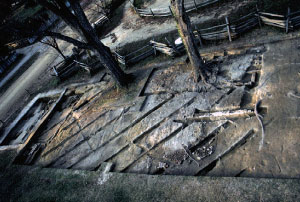
Refining the Program: 1982–2008
In 1982 Dr. Marley R. Brown, III replaced Ivor Noël Hume as Director of Archaeological Research. In some respects this transition caused few changes to field practices: today sites are still excavated stratigraphically, though baulks are no longer used, and ten-foot squares have been replaced by one-meter units. Artifacts are still saved, as are environmental data such as seeds, phytoliths (fossilized casts of plant cells), oyster shells, and animal bone, all of which can help reveal human behavior.
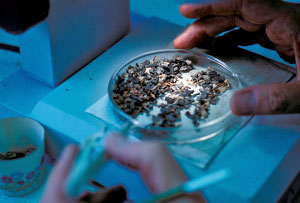
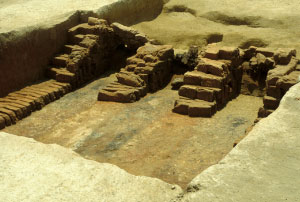
Advances in technology opened new avenues of research that continue to transform the archaeological research conducted at Colonial Williamsburg. Soils are tested for their chemical composition; distribution patterns of artifacts are recorded and scrutinized; and we have benefited from site previewing techniques such as ground-penetrating radar and soil resistivity testing.
The annual field school in historical archaeology, held each summer in conjunction with the College of William & Mary's Department of Anthropology, got its start during this period. Since 1984 thousands of graduate and undergraduate students have learned to excavate on complex sites within the Historic Area and on its borders; some of these students are now widely recognized professionals in the archaeology world.
New topics emerged within Williamsburg's archaeological discussion during this period: the Archaeology of Enslaved and free African Americans, landscape archaeology, and the exploration of "foodways" (the activities surrounding procurement, preparation, and consumption of food). A desire to understand the growth and development of Williamsburg as Virginia's colonial capital led to a focus on Middle Plantation, the 17th-century town from which Williamsburg sprung, and Jamestown, which preceded it as the capital of colonial Virginia. How this development was mirrored in other places prompted studies in comparative colonialism in Bermuda and Barbados.
The most fundamental shift since 1982, however, was defined by a more anthropological, or comparative, approach. How did the clientele of Shields Tavern compare to that of Wetherburn's or Charlton's? Where did a gunsmith fit in the social pecking order of early 18th-century Williamsburg? How did the diet of an elite, 17th-century urbanite differ from that of an 18th-century rural plantation owner, or that of his slaves? The ability to make these comparisons, and to answer these questions depends heavily on the accumulation of more than 50 years of solid archaeological research.
Defining characteristics of the Third Period:
- Open area, stratigraphic excavation.
- Careful collection of environmental data in addition to artifacts.
- "Anthropological" approach, often using quantitative analysis.
- Attention to detailed recording and stratigraphic analysis.
- Multi-disciplinary approach using tools from the physical sciences (resistivity testing, neutron activation).
- Focus on interpretation and education.
Examples of excavated sites:
The Peyton Randolph property, Shields Tavern, the Thomas Everard site, St. George Tucker Garden, the Coffeehouse, the John Page site, and Rich Neck Plantation.
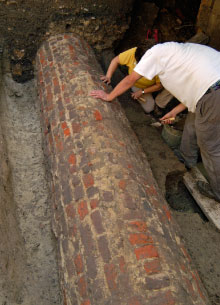
Building New Audiences: Archaeology Since 2008
A significant increase in excavation has characterized the most recent phase of Colonial Williamsburg's archaeological history. Occasioned by three back-to-back property reconstructions (Richard Charlton's Coffeehouse from 2008 to 2009, the Public Armoury from 2010 to 2013, and the Market House from 2013 to 2015), this uptick in fieldwork seems vaguely reminiscent of the pace and architectural focus of Colonial Williamsburg's early years. But the results have been quite different.
While careful excavation will always precede Colonial Williamsburg's brick-and-mortar reconstructions, architects, carpenters, and brick masons are no longer the end consumers of archaeological data. New technology, in a variety of forms, is shaping the product of archaeological research, and placing it in the hands of new audiences.
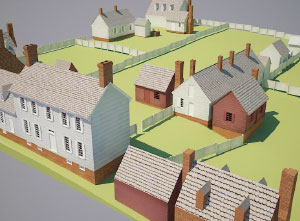
Among the most innovative of these projects has been collaboration between archaeologists and computer modelers in Colonial Williamsburg's Digital History Center. Since 2009, in the context of the Virtual Williamsburg initiative, modelers have been drawing on more than half a century of stratigraphic excavation data to construct phased 3D computer models interpreting changes to Williamsburg's built and natural landscapes. While carpenters were rebuilding the 1779 Public Armoury complex on Duke of Gloucester Street, modelers rendered the property five years prior, when it was still an uncluttered tavern yard. The ability to visualize change through time has proven to be both a powerful research tool and an engaging method for broader public interaction. In the words of one archaeologist, "it is as if the interpretive technology has caught up with the strengths of the archaeological data."
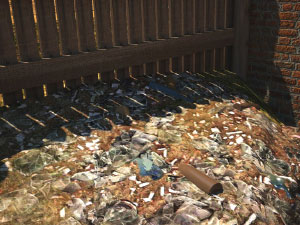
In addition to allowing "virtual time travel," computer modeling has provided a stage for decades' worth of archaeological information that was unfit, impossible, or unpleasant to replicate within the context of a living history museum. For example, recent forays into Williamsburg's 18th-century ravines, many of them long since filled, have provided archaeologists with a new sense of the town's former landscape. Restoring these enormous features to the physical landscape would be impossible, but within the Virtual Williamsburg model those steep, trash-filled ravines that once bordered the Coffeehouse and Armoury lots have been restored, as have backyard trash pits, weed-choked backyard corners, and the near-treeless streets revealed by archaeobotanical research.
Since 2009, webcams and blogs have introduced new and sometimes unsuspecting audiences to the archaeological process, and to its role in research. Focused on reconstruction projects at the Coffeehouse, Armoury, and Markethouse, these tools have captured excavation in real time, and have allowed lively interactions between webcam watchers and Colonial Williamsburg's staff. Common misconceptions have been clarified, updates shared, and predictions made about what will be found next. Through these exchanges, and through other social media sites such as Facebook, a group of geographically scattered visitors has coalesced into a sustained "local audience" for Colonial Williamsburg's archaeology program.
Finally, recent excavations at the Brafferton and the Bray School sites have opened opportunities to engage with, and to be accountable to, Native American and African descendant communities. In 2011 and 2012 excavations at the Brafferton Indian School were carried out in consultation with the Brafferton Legacy Group, an advisory body made up of William & Mary Native American alumni. A commemorative ceremony honoring the Brafferton's history as an Indian School was held at the outset of the fieldwork, and regular updates were provided to Legacy group members. Members of the Legacy group, in turn, assisted with the site's interpretation to visitors and guests, and one member participated in the excavations. Likewise, excavations at the Bray School site were carried out with the support of the College of William & Mary's Lemon Project—a program designed to encourage scholarship on the 300-year relationship between African Americans and the College, and to build bridges between the College and the community. The Bray School project's archaeological fieldwork built upon archival research carried out by Lemon Project staff, and the results were presented directly to Williamsburg's descendant African American community after each season of excavation.
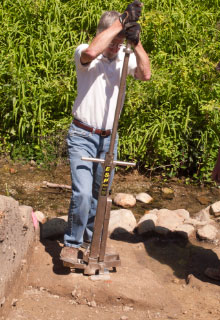
Defining characteristics of the Fourth Period:
- Open area, stratigraphic excavation.
- Careful collection of artifacts and environmental data.
- Attention to detailed recording and stratigraphic analysis.
- Increased collection and interpretation of landscape data (topography)
- Use of technology to convey archaeological research.
- Increased interaction with public audiences, and with "stakeholders".
- Relaxing the boundaries between archaeology and other areas of research.
Examples of excavated sites:
The Coffeehouse, James Anderson's Blacksmith Shop and Public Armoury, the Bray School, the Secretary's Office ravine, the Market House site, and the Wren Yard site.
Meredith Poole is a Staff Archaeologist in the Department of Architectural and Archaeological Research. This paper was written in 2001 for an educational program conducted by the department, and updated in 2014.
